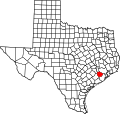2020 census
Four Corners CDP, Texas – Racial and ethnic composition
Note: the US Census treats Hispanic/Latino as an ethnic category. This table excludes Latinos from the racial categories and assigns them to a separate category. Hispanics/Latinos may be of any race.| Race / Ethnicity (NH = Non-Hispanic) | Pop 2000 [21] | Pop 2010 [22] | Pop 2020 [23] | % 2000 | % 2010 | % 2020 |
|---|
| White alone (NH) | 665 | 846 | 877 | 22.51% | 6.83% | 7.25% |
| Black or African American alone (NH) | 543 | 3,794 | 3,571 | 18.38% | 30.64% | 29.51% |
| Native American or Alaska Native alone (NH) | 1 | 21 | 28 | 0.03% | 0.17% | 0.23% |
| Asian alone (NH) | 471 | 4,277 | 4,024 | 15.94% | 34.54% | 33.25% |
| Native Hawaiian or Pacific Islander alone (NH) | 1 | 2 | 1 | 0.03% | 0.02% | 0.01% |
| Other race alone (NH) | 0 | 42 | 64 | 0.00% | 0.34% | 0.53% |
| Mixed race or Multiracial (NH) | 57 | 255 | 174 | 1.93% | 2.06% | 1.44% |
| Hispanic or Latino (any race) | 1,216 | 3,145 | 3,364 | 41.16% | 25.40% | 27.79% |
| Total | 2,954 | 12,382 | 12,103 | 100.00% | 100.00% | 100.00% |
As of the 2020 United States census, there were 12,103 people, 3,012 households, and 2,908 families residing in the CDP.
As of the census [1] of 2000, there were 2,954 people, 775 households, and 702 families residing in the CDP. The population density was 1,038.2 inhabitants per square mile (400.9/km2). There were 824 housing units at an average density of 289.6 per square mile (111.8/km2). The racial makeup of the CDP was 42.76% White, 18.96% African American, 0.64% Native American, 15.94% Asian, 0.03% Pacific Islander, 18.82% from other races, and 2.84% from two or more races. Hispanic or Latino of any race were 41.16% of the population.
There were 775 households, out of which 57.4% had children under the age of 18 living with them, 74.3% were married couples living together, 10.2% had a female householder with no husband present, and 9.4% were non-families. 7.2% of all households were made up of individuals, and 2.7% had someone living alone who was 65 years of age or older. The average household size was 3.81 and the average family size was 4.02.
In the CDP, the population was spread out, with 36.7% under the age of 18, 10.0% from 18 to 24, 29.1% from 25 to 44, 19.3% from 45 to 64, and 4.8% who were 65 years of age or older. The median age was 28 years. For every 100 females, there were 100.0 males. For every 100 females age 18 and over, there were 97.8 males.
The median income for a household in the CDP was $63,534, and the median income for a family was $65,200. Males had a median income of $34,821 versus $40,272 for females. The per capita income for the CDP was $19,826. About 12.1% of families and 16.3% of the population were below the poverty line, including 23.4% of those under age 18 and 15.0% of those age 65 or over.
From the 2000 census to the 2010 census, the population increased to 12,382, about four times the population in 2000. As of 2011 90% of the residents are Asian Americans, African-Americans, and Latino Americans. Between the 2000 and 2010 censuses, the number of White Americans increased while the percentage of Whites decreased. Jeannie Kever of the Houston Chronicle said that "not all of the newcomers identify with the old neighborhood and its inhabitants, even those living just a block away." [6]
Karl Eschbach, a former demographer for the state of Texas, said that many people moved from Houston neighborhoods and communities with distinct racial and socioeconomic identities, like the East End, Sunnyside, and the Third Ward, to areas too new to have racial identities. Eschbach explained that "as a large minority middle class started to emerge, Fort Bend was virgin territory that all groups could move to." [6] When explaining why many of the new residents were of minority groups rather than white Americans, Eschbach added, "Many minorities are looking for mixed communities, where whites might feel it's more optimal to live in a subdivision that's more homogeneous with their own group." [6]
Kever said that in previous eras, "Four Corners has always been a multicultural mashup, its residents united by poverty and an appreciation for life in the slow lane." [6] By 2011 many newer residents were wealthier than the original residents. [6]





